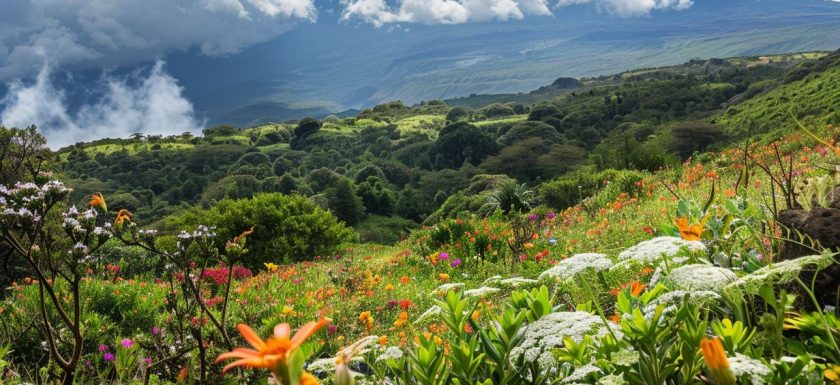
Kilimanjaro, the iconic African peak, is known for its towering summit and diverse plant life on its slopes.
We explore the plants found on Kilimanjaro and how extreme altitude affects their growth, including the Giant Groundsel and Kilimanjaro Impatiens.
We discuss the vital role these plants play in the ecosystem, threats they face from climate change and human impact, and conservation efforts to protect them.
Come along to discover the beauty and importance of Kilimanjaro’s flora and learn how we can all contribute to preserving this natural wonder.
Key Takeaways:
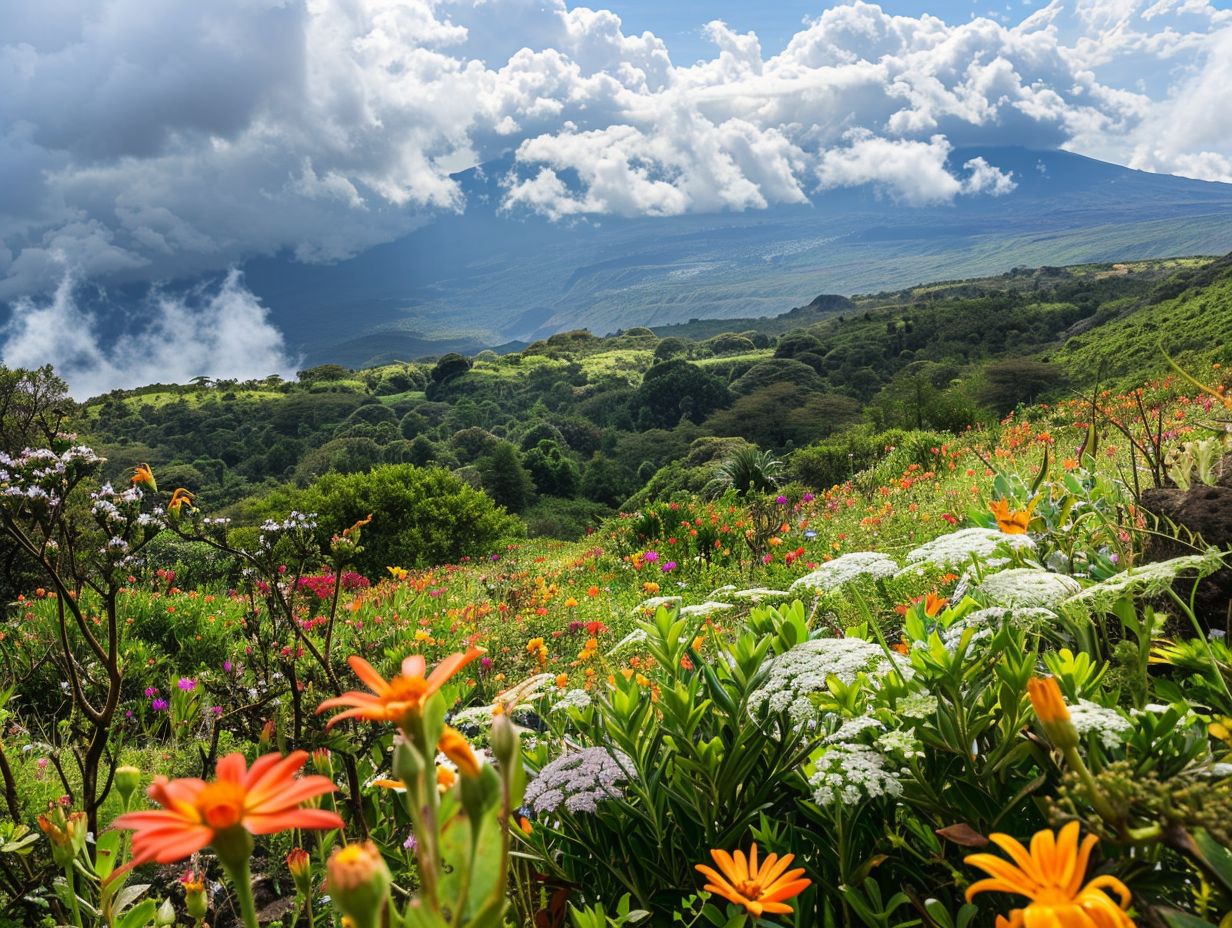
- The diverse flora on Kilimanjaro includes unique species such as the Giant Groundsel, Kilimanjaro Tree Lobelia, and Kilimanjaro Impatiens.
- Plants on Kilimanjaro have adapted to extreme conditions, playing a crucial role in the ecosystem and providing essential resources for other living organisms.
- Climate change and human impact are threatening the flora on Kilimanjaro, but conservation efforts are being made to protect and preserve these valuable plant species.
The Flora of Kilimanjaro
Kilimanjaro, located in East Africa, boasts a diverse array of flora across its vegetation zones, showcasing a rich tapestry of plant life that thrives in various habitats and elevations.
This awe-inspiring mountain is home to a multitude of plant species, each uniquely adapted to its specific zone.
- Starting from the lush montane forests carpeting the lower slopes, hikers are greeted by a canopy of towering trees, ferns, and vibrant flowers.
- As ascent continues, the landscape transitions into heath and moorland, where hardy shrubs, tussock grasses, and strange giant lobelias dominate the scenery.
- The alpine desert zone further up is a stark contrast, with mainly lichens, mosses, and hardy perennial plants eking out a living in this harsh, arid environment.
What Types of Plants can be Found on Kilimanjaro?
The vegetation on Kilimanjaro ranges from lush rainforests in lower altitudes to sparse Alpine deserts at higher elevations, hosting a plethora of plant species uniquely adapted to their specific habitats.
As one ascends the mountain, they will encounter different vegetation zones, each characterized by distinct flora. The montane forest belt, situated between 1,800 and 2,800 meters, is dominated by mosses, ferns, and tree species like Podocarpus and Croton.
Moving further up, the heath and moorland zone, ranging from 2,800 to 4,000 meters, showcases heather, giant lobelias, and Senecio plants, which have evolved to withstand the harsh conditions of high altitudes. At the summit, above 4,000 meters, the rocky terrain defines the Alpine desert with hardy plants such as everlasting flowers and lichens clinging to the volcanic rock.
How Does the Altitude Affect the Flora on Kilimanjaro?
The altitude gradient on Kilimanjaro plays a pivotal role in shaping the flora, with distinct vegetation zones emerging at different heights, showcasing specialized plant adaptations to the challenging mountain climate.
As one ascends Kilimanjaro, they would first encounter the lush montane forest zone, where tree species like African yellowwoods and olive trees thrive thanks to abundant moisture.
Moving higher, the heath and moorland zone greet hikers with hardy plants such as giant lobelias and groundsels, equipped with unique fuzzy leaves to retain moisture and survive the harsh conditions.
Further up, the alpine desert zone dominates, with only low-growing cushion plants like the endemic Kilimanjaro plantain dotting the landscape, grappling with extreme temperatures and limited water supply.
The Unique Plant Species of Kilimanjaro
Kilimanjaro is home to several unique plant species, including the impressive Giant Groundsel and the iconic Lobelia, adding to the mountain’s distinct floral charm.
These exceptional plant species have evolved over time to withstand the challenging high-altitude conditions of Kilimanjaro, contributing significantly to the mountain’s biodiversity. The Giant Groundsel, with its towering structure and large, daisy-like flowers, is a sight to behold against the backdrop of the mountain’s slopes.
On the other hand, the Lobelia plants, with their unique trumpet-shaped blooms in shades of blue and purple, not only add beauty to the landscape but also play a crucial role in supporting the local ecosystem by providing shelter and food for various wildlife species.
The Giant Groundsel
The Giant Groundsel, a remarkable endemic species of Kilimanjaro, thrives in the harsh conditions of the Alpine desert zone, with its towering stature and distinctive appearance becoming a symbol of the mountain’s unique flora.
Its adaptation to the extreme climate and high-altitude environment showcases the resilience of this plant, which can reach heights of up to 5 meters.
The unique rosettes of bright yellow flowers at the top of its stem make it easily recognizable amidst the rocky terrain. Being endemic to Kilimanjaro, it plays a crucial role in the local ecosystem, providing shelter and food for various wildlife species, including birds and insects.
The Kilimanjaro Tree Lobelia
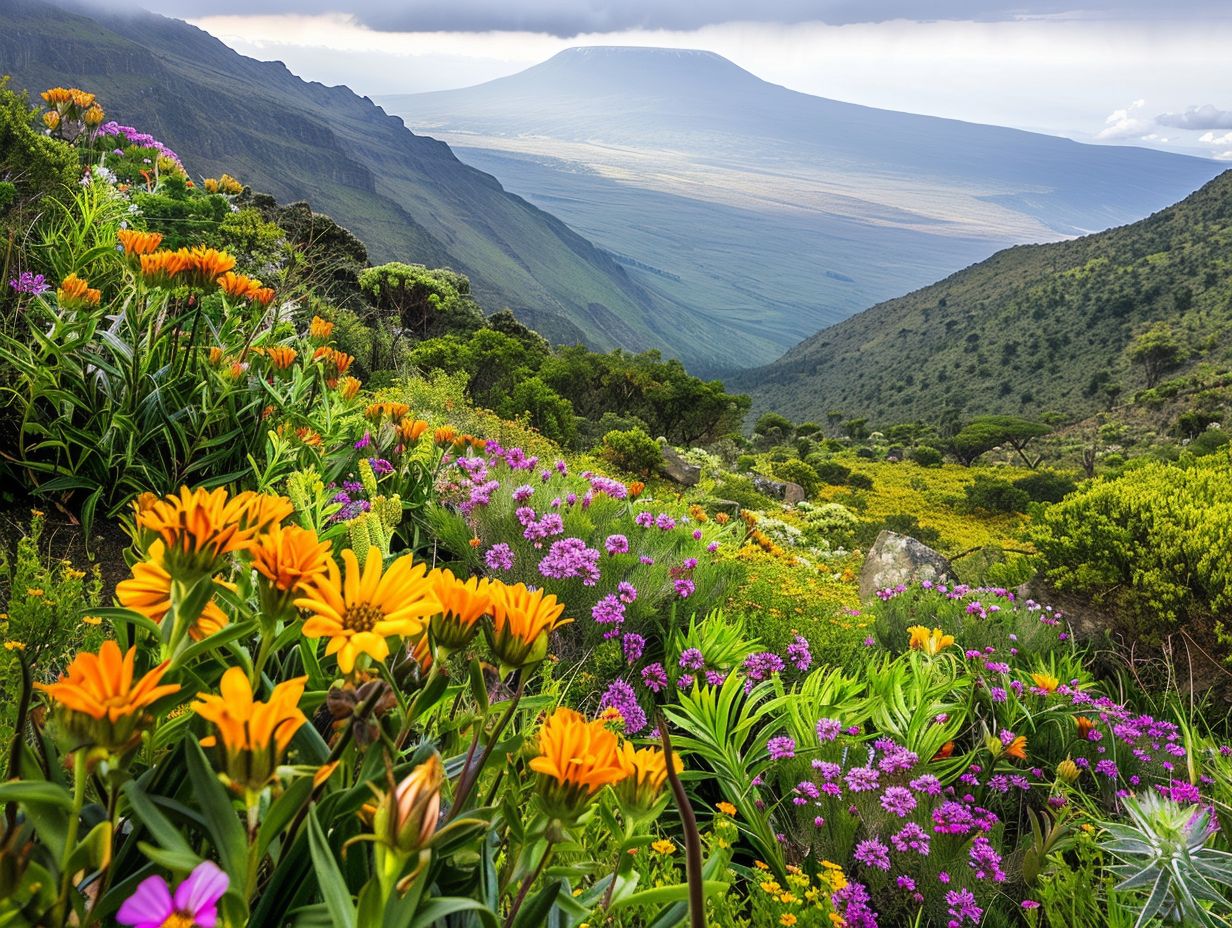
The Kilimanjaro Tree Lobelia, a striking endemic species found in the forest zone of the mountain, captivates with its unique structure and contribution to the lush vegetation of Kilimanjaro.
Standing tall with its elongated, spiky leaves that form a crown-like appearance, the Kilimanjaro Tree Lobelia is a botanical wonder that thrives in the montane forests of the region. The plant’s majestic stature, often reaching heights of over 10 feet, adds a vertical dimension to the diverse flora of Kilimanjaro, enhancing the scenic beauty of the landscape.
As an endemic species, the Kilimanjaro Tree Lobelia plays a crucial role in supporting the local ecosystem. Its vibrant flowers attract pollinators, contributing to the overall biodiversity of the area and ensuring the sustainability of the plant community.
The Kilimanjaro Impatiens
The Kilimanjaro Impatiens, an exquisite endemic species thriving in the moorland zones of Kilimanjaro, adds a splash of color and uniqueness to the mountain’s already diverse flora.
This fascinating plant, known for its vibrant hues and delicate blooms, has evolved remarkable adaptations to the challenging conditions of the moorland environment. With its ability to thrive in the thin, nutrient-poor soils and withstand the fluctuating temperatures characteristic of this ecosystem, the Kilimanjaro Impatiens showcases nature’s resilience and ingenuity.
The Importance of the Flora on Kilimanjaro
The flora on Kilimanjaro plays a crucial role in sustaining the mountain’s delicate ecosystem, providing habitat and sustenance for a diverse array of wildlife while contributing to the overall biodiversity of the region.
Flourishing plant life on Kilimanjaro acts as the foundation of a complex web of interactions that support numerous species of animals, from majestic elephants to tiny insects.
Plants not only offer shelter and food but also play a vital role in maintaining the balance among different species, ensuring that the mountain’s ecosystem remains healthy and thriving. This intricate relationship between the diverse flora and fauna contributes to the uniqueness and resilience of Kilimanjaro’s ecosystem.
How do Plants Adapt to the Harsh Conditions on Kilimanjaro?
Plants on Kilimanjaro have evolved unique adaptations to thrive in the mountain’s harsh conditions, demonstrating resilience and specialized features that enable their survival in challenging environments.
One notable adaptation of plants on Kilimanjaro is their ability to store water in their thick succulent leaves to survive the arid conditions prevalent at higher altitudes. This water-conservation strategy allows them to endure prolonged periods of drought.
Many plant species on Kilimanjaro exhibit compact growth forms, minimizing surface area exposed to harsh winds and reducing water loss through evaporation. Some plants have developed unique root systems that enable them to access water deep within the rocky terrain, ensuring their hydration even during dry spells.
What is the Role of Plants in the Ecosystem of Kilimanjaro?
Plants form the foundational backbone of the ecosystem on Kilimanjaro, providing essential services such as oxygen production, soil stabilization, and food sources that support a myriad of wildlife and maintain the delicate balance of the mountain’s environment.
The diverse range of plant species on Kilimanjaro not only offer vital sustenance for various herbivores but also provide crucial shelter and nesting grounds for a wide array of fauna.
These plants also play a critical role in regulating water flow, preventing erosion, and influencing local microclimates, thus contributing significantly to the environmental stability of the region.
Their intricate interaction with the soil and atmosphere aids in maintaining the overall health and resilience of the ecosystem, making them essential components in the intricate web of life on the majestic mountain.
The Threats to the Flora on Kilimanjaro
Despite its resilience, the flora on Kilimanjaro faces mounting threats from climate change and human activities, posing significant challenges to the preservation of its diverse plant life and fragile ecosystem.
Climate change is altering the temperature and precipitation patterns on Kilimanjaro, disrupting the delicate balance that sustains diverse plant species in this iconic region. The melting glaciers not only impact water availability but also contribute to soil erosion, threatening the survival of endemic plants. Human interventions such as deforestation for agriculture and settlement further exacerbate the situation, leading to habitat destruction and fragmentation.
Climate Change
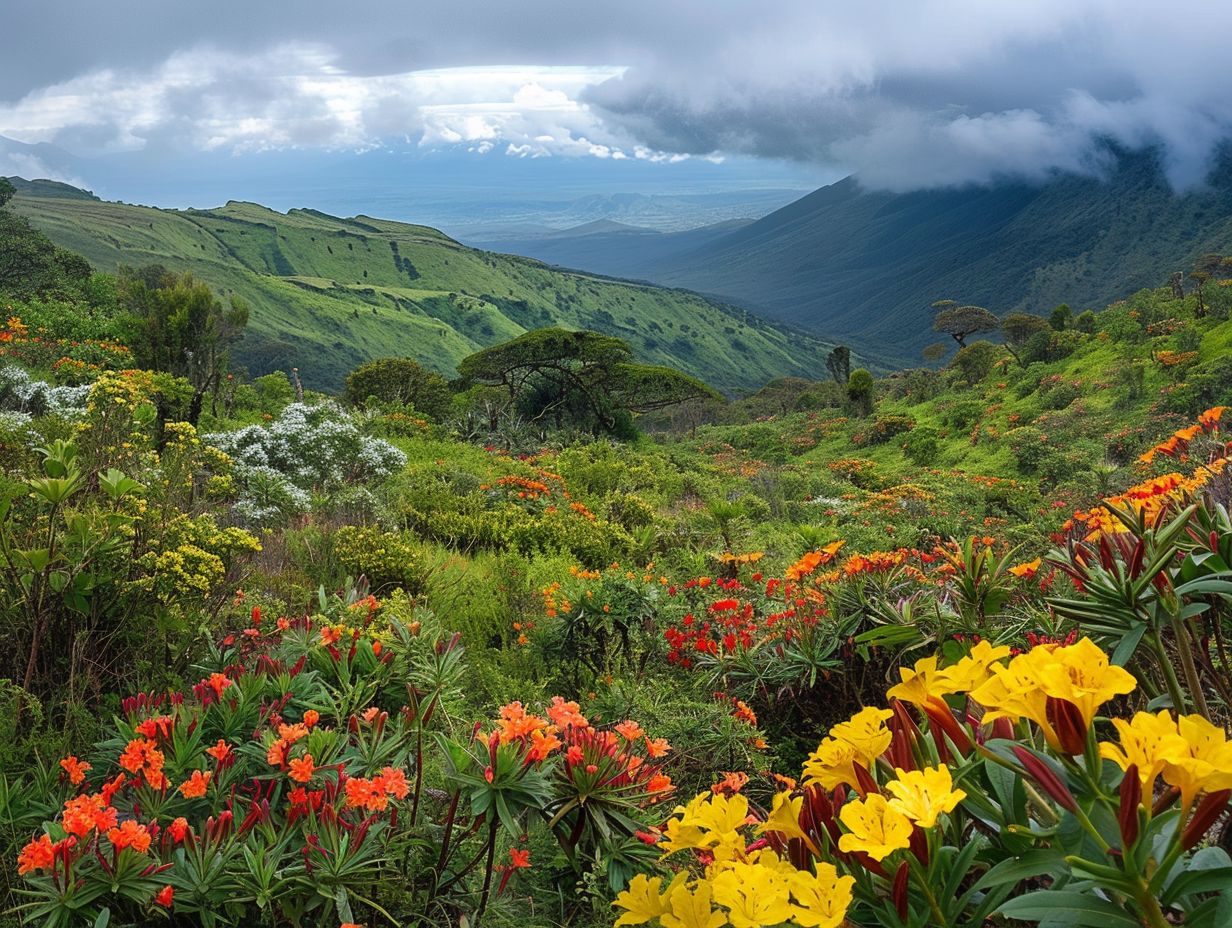
Climate change poses a significant threat to the flora on Kilimanjaro, disrupting ecosystems, altering habitats, and challenging the adaptability of plant species to rapidly changing environmental conditions.
The impact of climate change on Kilimanjaro’s plant life is profound; as temperatures rise, certain plant species are struggling to survive in their native habitats. This disruption in ecosystems not only affects individual plants but also cascades through the entire biodiversity of the region.
Adaptability becomes a key factor as plants face challenges in coping with the altered precipitation patterns and shifting temperature ranges. These changes disturb the delicate balance of the ecosystem dynamics on the mountain, leading to potential loss of plant diversity.
Human Impact
Human activities such as deforestation, habitat destruction, and land degradation exert pressures on the flora of Kilimanjaro, diminishing biodiversity and disrupting the delicate balance of the mountain’s ecosystem.
These destructive actions not only threaten the existence of numerous plant species indigenous to Kilimanjaro but also jeopardize the interconnected web of life that depends on the rich vegetation of the region.
Deforestation leads to the loss of vital habitats for unique flora, pushing many species towards extinction and reducing overall genetic diversity. The rampant clearing of forests for agriculture and settlements accelerates soil erosion, altering the landscape and resulting in significant ecological imbalances.
Conservation Efforts for the Flora on Kilimanjaro
Efforts to conserve the flora on Kilimanjaro are underway, aiming to safeguard the diverse plant species, preserve critical habitats, and promote sustainable practices that ensure the long-term health of the mountain’s ecosystem.
One vital aspect of the conservation initiatives is the identification of key plant species endemic to Kilimanjaro and implementing targeted protection strategies. These efforts involve collaborating with local communities to raise awareness about the importance of preserving native vegetation.
By establishing nurseries that propagate indigenous plants, conservationists strive to restore degraded areas and enhance biodiversity. Sustainable tourism practices are being encouraged to minimize environmental impact while supporting the local economy, ultimately fostering a harmonious relationship between conservation and socio-economic development.
What is Being Done to Protect the Flora on Kilimanjaro?
Dedicated conservation programs and initiatives on Kilimanjaro are working towards safeguarding the unique flora, implementing conservation strategies, and raising awareness about the importance of preserving the rich biodiversity of the mountain.
One of the key strategies employed to protect the diverse plant life on Kilimanjaro is the establishment of protected areas and buffer zones to limit human impact on the ecosystem. Through these measures, flora endemic to the region are given space to thrive and reproduce without disturbance.
Additionally, community involvement plays a vital role in conservation efforts, with local residents actively participating in reforestation projects, seed collection initiatives, and sustainable land use practices to preserve the natural habitat.
How Can We Help Conserve the Flora on Kilimanjaro?
Individual efforts to conserve the flora on Kilimanjaro can include supporting local conservation projects, practicing responsible tourism, and spreading awareness about the importance of maintaining the ecological balance of the mountain.
By engaging with local conservation initiatives, individuals can directly contribute to preserving the unique plant species that thrive in the diverse ecosystems of Kilimanjaro.
Supporting sustainable practices in agriculture and land use can also aid in safeguarding the natural habitats from degradation and deforestation. It is essential to prioritize environmentally friendly activities while exploring the mountain, such as minimizing waste, respecting wildlife, and opting for eco-friendly accommodation options.
Frequently Asked Questions
What types of flora can be found on Mount Kilimanjaro?
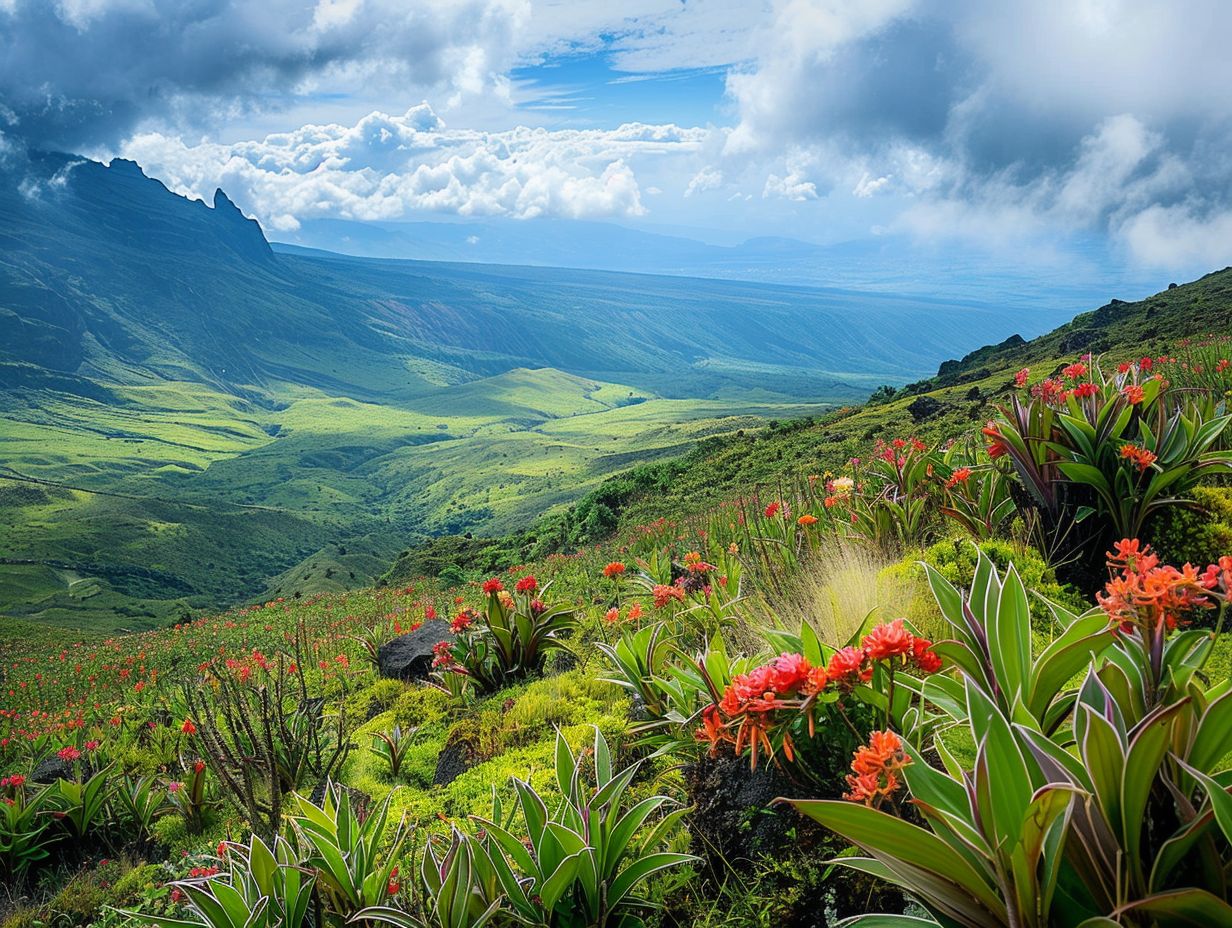
Some of the common types of flora found on Mount Kilimanjaro include Lobelias, Senecios, and Giant Groundsels. These plants are unique to the mountainous regions of Tanzania and can be found at different elevations on Kilimanjaro.
How do plants adapt to the harsh conditions on Mount Kilimanjaro?
Plants on Kilimanjaro have adapted to the extreme temperatures, high altitude, and low oxygen levels by developing thick, waxy leaves to retain moisture, growing close to the ground to reduce wind exposure, and having shallow root systems to absorb water quickly.
Are there any endemic plant species on Kilimanjaro?
Yes, there are several endemic plant species that can only be found on Mount Kilimanjaro. These include the Kilimanjaro Tree Lobelia, Kilimanjaro Violet, and Kilimanjaro Impatiens. These plants have evolved to survive in the unique environment of the mountain.
Why is it important to preserve the flora on Kilimanjaro?
The flora on Kilimanjaro plays a crucial role in maintaining the fragile ecosystem of the mountain. They provide food and shelter for various wildlife, prevent soil erosion, and contribute to the water cycle. Preserving these plants is essential for the overall health of the mountain.
Can I find any medicinal plants on Mount Kilimanjaro?
Yes, there are several medicinal plants that grow on Kilimanjaro, such as the East African Sandalwood, which is used for its aromatic oil, and the East African Greenheart, which has anti-inflammatory properties. However, it is important to consult with a local guide before using any plants for medicinal purposes.
How has climate change affected the flora on Kilimanjaro?
Climate change has had a significant impact on the flora on Kilimanjaro. The rising temperatures and changing weather patterns have caused some plants to migrate to higher elevations, while others have become endangered. It is crucial to address climate change to protect the unique flora on the mountain.